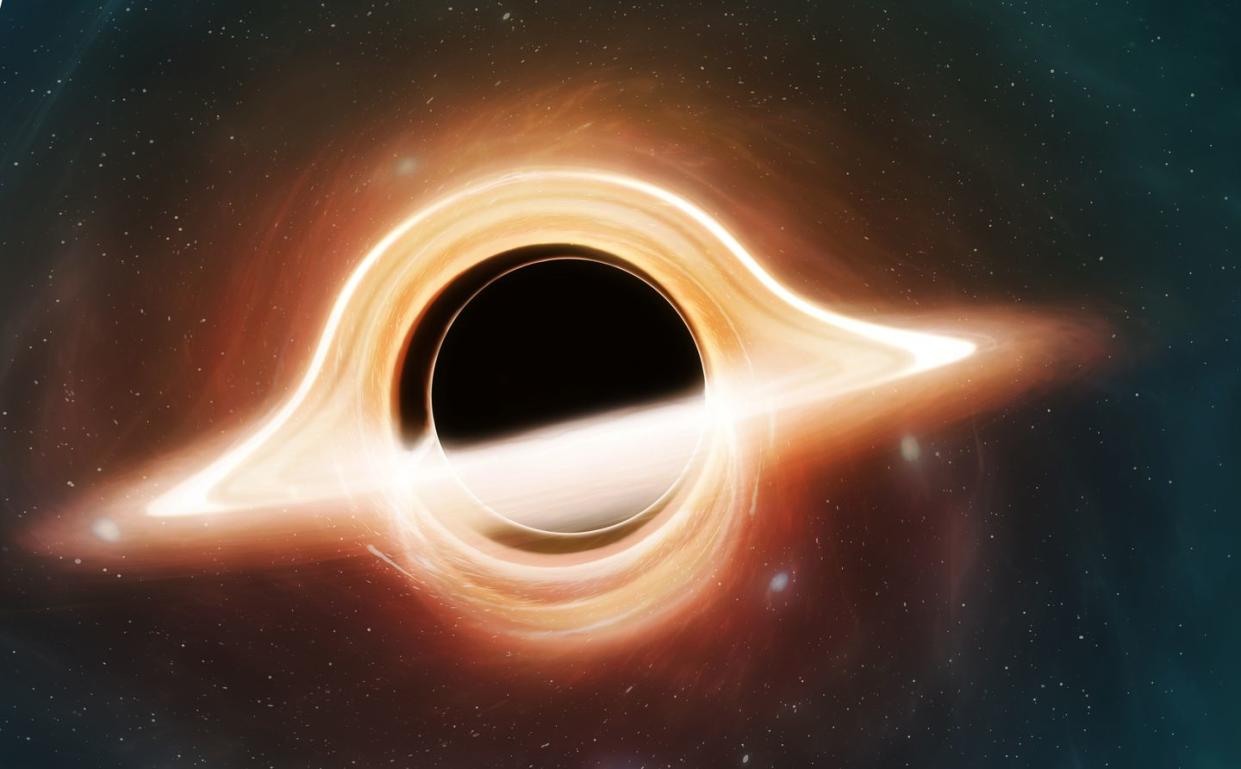The Universe May Be a Hologram, Meaning Our Entire Reality Could Be an Illusion

As theoretical physics delves deeper into the fundamental nature of reality, we’re left to grapple with the questions it leaves us. For example, some physicists claim that our universe is merely an illusion, a product of quantum machinations happening in a lower-dimensional setting—in other words, a hologram.
But do these latest theoretical insights offer revelations into reality, itself, or merely serve as mathematical tools to help us solve thorny problems? When it comes to the most cutting-edge physical theories, what is a product of our imaginations, and what is a product of the universe?
Black Holes May Be Evidence
The trouble began with those bothersome boogeymen of the cosmos, black holes. On the surface (and careful readers will be rewarded later with the realization that this is a pun), black holes are simple; stuff falls in and never gets out. All the information about that stuff gets locked away behind the event horizon, never to be seen again. But in the 1970s, famed astrophysicist Stephen Hawking realized that black holes aren’t entirely black. They’re a little gray and a little leaky, emitting a tiny amount of radiation, which causes black holes to evaporate slowly, but inevitably, from existence altogether.
However, that radiation carries no information with it, which brings up a nasty paradox: information goes in, but doesn’t come out, and then the black hole goes away. So what happened to all the information?
✅ In this context, information is the list of all the properties of all the particles that fell into the black hole—in other words, everything you need to reconstruct the original objects that fell in. Instead, what comes out of a black hole, due to Hawking radiation, is just a bunch of random particles. You can’t tell what fell in based on the radiation coming out.
A major clue came in the decades that followed Hawking’s extraordinary discovery. One way to measure the amount of information is through entropy, a thermodynamic concept that is loosely related to the amount of disorder in a system. Black holes have a surprising property: their entropy is proportional to their surface area, not their volume. In other words, the amount of information in a black hole is related to its two-dimensional surface, not its three-dimensional volume.
✅ The concept of entropy describes a system’s tendency to move from order toward disorder, because there are so many more ways for a disordered state to exist than an ordered state. For example, you could clean your room, and there’s only one way for that room to be clean. Yet, there are countless ways for it not to be clean, or become chaotic, like adding a smudge of dirt or a stray sock in a corner. So over time, entropy must increase. That goes for any system in the universe, not just your room.
This is pretty much unlike every other object in the entire universe, and so naturally a lot of physicists all of sudden became very interested in black holes, with top-tier physicists like Leonard Susskind leading the charge into this new land of the holographic principle. The name comes from holography itself. Ever see a hologram in real life, and it looks like the image leaps out at you? That’s because the hologram encodes all the three-dimensional information in a two-dimensional surface.

So, there appears to be something funny about black holes, wherein their information seems to be encoded on their two-dimensional surfaces. Perhaps the same is true for the whole entire universe.
A Two-Dimensional Universe?
This idea isn’t as crazy as it first appears, because we might actually have a working example of the holographic principle in action. It’s known by the rather awkward name of the AdS/CFT correspondence, and it was developed in 1997 by physicist Juan Maldacena.
To understand, let’s construct a special kind of universe with some strange properties. One, this universe has five spatial dimensions. Two, it’s completely empty of matter and radiation. Three, it contains a persistent cosmological force that bends it inward. This kind of spacetime is called a (five-dimensional) anti-de Sitter space.
Now, let’s say you’re trying to solve a very complicated problem within that universe, like how quantum gravity works. We’ve been trying to solve quantum gravity for almost a century now, and while we don’t have any answers yet, we do have a set of tools that we hope someday will lead us to one. That set of tools is known as string theory.
✅ Let’s unpack some more complex concepts.
Quantum gravity is an understanding of gravity applied to the smallest things in the universe, such as subatomic particles. We can understand the behavior of these particles using quantum mechanics, but when gravity becomes strong, like inside of black holes, our theories break down. Quantum gravity is an attempt to fix those broken theories.
Quantum fields are entities that soak the entire universe. When patches of the fields are energized, we see the creation of particles or the exchange of forces.
Conformal field theory is a type of quantum field theory that has certain special mathematical properties. These kinds of theories have limited applications in some high-energy physics experiments, but are not very useful outside of that.
Maldacena discovered that you can transform this problem—the problem of how to solve for quantum gravity in this weird universe—into a completely different problem living on its four-dimensional boundary. After you make that transformation, all the gravity goes away, replaced with a special kind of quantum theory known as a conformal field theory (which is the CFT part of the correspondence). By now, we’ve become extremely adept at solving quantum field theory problems, and we have a whole host of well-tested tools for working through those kinds of mathematics.
Maldacena performed the theoretical physics equivalent of a magic trick: he was able to take a problem that we don’t know how to solve (quantum gravity with string theory) and transform it into one that we can solve (a conformal field theory with quantum fields).
Is This The Origin of Spacetime?
And here’s where things go really wild. Some physicists have developed and extended this idea away from a mere tool for solving headache-inducing gravity problems to explaining gravity itself. They claim they’ve discovered correspondences where the quantum nature of all the fields living at the boundary of this spacetime cause general relativity to appear within it. General relativity is our description of the force gravity, where we view gravity in terms of bends and wrinkles in space and time. So in other words, the holographic principle may be telling us that quantum interactions living on the borders of our universe literally manifest spacetime within it.
If this is correct, then what we perceive to be a three-dimensional universe, filled with interesting and fun objects interacting through gravity, is really a two-dimensional surface filled with exotic quantum shenanigans from which all else emerges.
That’s a big if.
Despite decades of work along these lines, the holographic principle has a few shortcomings. For one, its theoretical darling, the AdS/CFT correspondence, is at this stage only a conjecture about what might be true based on certain observed mathematical relationships; nobody has actually proven the correspondence to be true. Plus, even if we did, the universe described by the correspondence looks nothing like the one we live in. Our universe has three spatial dimensions, not five, and it has a temporal dimension. It is not empty, and does not close in on itself, but is instead filled with matter and radiation, and is currently undergoing a phase of accelerated expansion. Most critically, our universe does not have a well-defined border, so the entire raison d’être of the holographic principle is dead in the water.
Secondly, the vast majority of physical theories that apply to real-life problems in the universe are emphatically not conformal field theories, so the utility of the AdS/CFT correspondence is not guaranteed (although it has been put to work in some interesting cases).
And even as intriguing as the nature of black-hole information appears to be, nobody has been able to successfully wield the holographic principle to describe exactly what happens to real black holes in the real universe. Not to mention, the whole weird entropy thing about black holes does not apply to other objects: if I stuff information into you, for example, the entropy goes up proportionally to your volume.
But hey, it’s a young field. It took physicists and chemists over a century to finally decide that atoms existed, so it’s a little unfair to rush to judgement over brand-new insights into reality. But what if their wildest dreams came true? What if we were to find an intimate connection between the physics of our three-dimensional universe and the physics on the boundary?
So, Is Our Universe a Hologram? Or a Mathematical Illusion?
The implications of the holographic theory are murky, at best. Some physicists have already gone all the way, stating that our reality is an illusion, that what we perceive as space and time and gravity are just manifestations of a deeper reality existing in fewer dimensions—that our universe is, quite literally, a hologram.
But mathematical solutions to physical theories do not necessarily dictate reality. One could just as easily argue that, if the holographic principle turns out to be useful, then we have merely discovered a powerful—and even vital—mathematical tool for understanding our universe. But that doesn’t mean that what the math tells us is real.
For example, physicists routinely employ a myriad of mathematical games to solve problems. Sometimes problems get casted into higher or lower dimensions; sometimes they get morphed into the realm of imaginary numbers; sometimes we move processes back and forth in time. We recognize these tools for what they are: methods to solve challenging problems, not new formulations of the fundamental constituents of reality.
On the other hand, sometimes mathematical tricks get elevated and baked into our understanding of the physical universe. Take general relativity. Prior to Einstein’s work, we envisaged gravity as a force like any other, a set of invisible strings that connect every object with mass. But now we view gravity as deformations in the fabric of spacetime. We judge the view provided by general relativity to be more “real” than pre-Einstein understandings, by virtue of it providing greater accuracy and insight into the gravitational force. But you could just as easily say that it’s all a mathematical contrivance developed by our puny human brains to help us organize and understand the world, one that’s ultimately a fiction. In reality, the universe just does what the universe does.
If the holographic principle really does lead to a new and revolutionary conception of our universe, ultimately it will be up to us to decide if our reality as we understand it is an illusion, or if the physicists need to get back to work.
You Might Also Like
